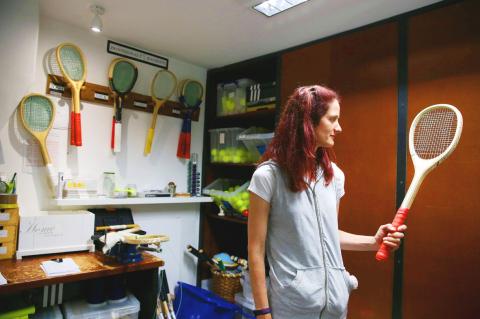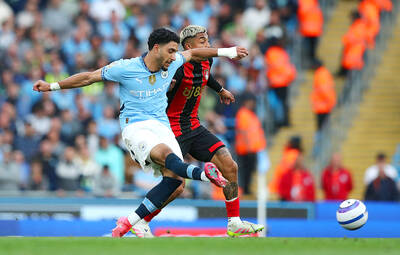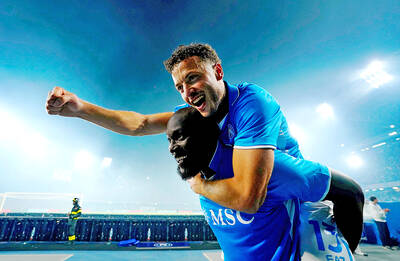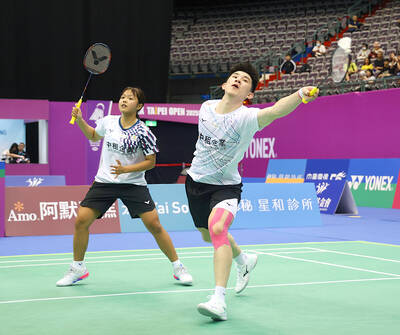As the dust settles at Wimbledon, the real tennis action is under way: The world’s best players of the original sport are dueling it out at the game’s spiritual home.
Real tennis, the historic forerunner of the modern sport, is still played on a few dozen courts across the globe, including at Hampton Court Palace in London.
On a court originally built in 1530 for King Henry VIII, the top players are laying chases and hitting boomerangs, giraffes and railroads — some of the sport’s quirky moves.

Photo: AFP
“It’s the best game ever. Simple,” said world champion Rob Fahey, considered the sport’s greatest player.
“It’s the beginning of everything,” the 50-year-old Australian said in the palace grounds. “The most important thing is to realize it isn’t tennis. It looks a lot like tennis, but a lot of games have derived from this, so we’ve got elements of squash and any other racquet sport you can think of. You’ve got to be a master of all trades.”
The Royal Tennis Court at Hampton Court Palace was built by kings, for kings to play on. It is the real tennis equivalent of Wimbledon’s Centre Court: the spiritual home of the game.
The Champions Trophy, disputed on the historic court and featuring the world’s top players, ends today.
It is one of the sport’s 10 tournaments earning ranking points.
Real tennis survives on fewer than 50 courts worldwide: About half are in Britain, with others in the US and a few in Australia and France.
The Royal Tennis Court is the busiest in the world, in constant use 364 days a year.
Clubs need to make their own balls, which are hard and solid, unlike lawn tennis balls.
Weighing 81g to 88g, they are comprised of crumbled wine corks, tightly wrapped in cling film and tied in twine, bound in cotton tape, then stitched into yellow felt.
“A well-made ball has to survive quite a robust game,” Royal Tennis Court head professional Nick Wood said as he finished making a ball.
The marker, a fellow pro who officiates over a match, needs quick reactions, ducking out of the way of shots.
“There is a certain amount of bravery,” Wood said. “The ball comes off the racquet at up to 160kph. It’s like an Exocet missile coming straight at you. It will break bones.”
The sport still uses wooden rackets with a small, angled head.
Lawn tennis-style graphite rackets were tried, but they were judged too powerful and “destroyed the grace and skill of the game,” Wood said.
The sport evolved as a street game played in medieval European courtyards, hence its asymmetrical layout, with what looks like a row of small shops along two sides whose windows and roofs are part of the court.
Its French name, jeu de paume, refers to the time before rackets when it was played with the open palm.
There were once 250 courts in Paris alone — there are now two in France. Rather than play in the dirty streets, the nobility had their own courts built.
Real tennis claims that several common phrases originate from the game: cut to the chase, off the wall, in the nick of time, from pillar to post and impress the gallery.
The sport declined in the 20th century as lawn tennis took over, but since the 1970s, new courts have been built and the game is growing.
Real tennis historian Lesley Ronaldson said lawn tennis was a simplified and therefore less complex sport.
“Real tennis has so much to offer,” the four-time British Open champion said. “Having to be fit, the mental game like chess and having to learn the techniques makes it altogether a fascinating game.”
Fahey won the biennial world championship — played over 13 sets across three days — unbroken from 1994 to 2014. He won the title back from 31-year-old US rival Camden Riviere in April.
“We’re very passionate,” the Tasmanian said of the sport’s 100-odd professionals and 10,000 or so enthusiasts worldwide.
“A game like this could fall off a cliff and potentially disappear, which would be heartbreaking, because it’s the original sport,” he said. “We’ve got to work hard to keep it alive.”

Omar Marmoush’s stunning long-range strike on Tuesday upstaged Kevin de Bruyne on the Manchester City great’s Etihad farewell. Marmoush let fly from about 30m to put City ahead in their 3-1 win against AFC Bournemouth in the Premier League. The victory moved Pep Guardiola’s team up to third in the standings and left qualification for the UEFA Champions League in their own hands heading into the last round of the season. “It’s really important. To be in the Champions League after what happened [this season] will be really nice,” the City manager said. De Bruyne was making his final home appearance for City before

TIGHT FINISH: Napoli only needed to do the same as or better than Inter, who won their game against Como 2-0 on the same day, leaving Napoli with a one-point lead The two players who Antonio Conte wanted more than any others secured Napoli their second Serie A title in three years on Friday. Scott McTominay scored with an acrobatic bicycle kick before halftime and Romelu Lukaku doubled the lead with a solo goal after the break in the decisive 2-0 home win over Cagliari. Conte became the first coach to win the Italian championship with three different teams. “Everyone contributed to this — but the coach most of all,” Napoli captain Giovanni Di Lorenzo said. “Napoli needed him to get back on top. He’s phenomenal.” Comparing it to his three Serie A titles won

The journey of Taiwan’s badminton mixed doubles duo Ye Hong-wei and Nicole Chan at the Malaysia Masters in Kuala Lumpur came to an end in the semi-finals yesterday after they suffered a 2-0 loss to China’s Feng Yanzhe and Huang Dongping. Ye, 25, and Chan, 20, teamed up last year and are currently ranked No. 23 in the world. The Taiwanese shuttlers took on China’s second seeds in the mixed doubles event, but proved no match for Feng and Huang, losing the match 10-21, 7-21. In the first half of the first game, the pairings were neck and neck at 6-7 until Ye

SSC Napoli coach Antonio Conte has dragged the team back from disaster and restored them to the top of Italian Serie A, but his future at the Scudetto winners is in doubt even after a triumphant season. The fiery 55-year-old has exceeded preseason expectations and bolstered his reputation as a serial winner by guiding Napoli to their fourth Scudetto, and second in three seasons. However, he might well be on his way in the summer after just one season at the helm as his charged relationship with Napoli owner Aurelio De Laurentiis has simmered throughout the campaign. Conte has said